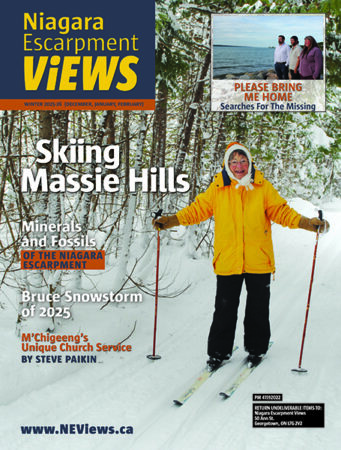We received the following letter from George Powell, Vice Chair of Watershed Action Group, Blue Mountain Watershed Trust Foundation. This was written to The Creemore Echo newspaper in Creemore, and concerns a proposed quarry haul route.
Re: Clearview Side Road 26/27 Proposed Reconstruction
The mission of the Blue MountainWatershed Trust is to “Preserve and Enhance the Blue Mountain WatershedEcosystem” and in this regard the application to the Niagara Escarpment Commission by Clearview Township to reconstruct Side Road 26/27 and to amend the Niagara Escarpment Plan is a concern and the reason for this letter to you. It is one we would like you to share with your readers.
Our concern arisesfrom the Minutes of Settlement and resulting Road Improvement Agreement between the County of Simcoe, the Township of Clearview and Walker Aggregates Inc. The essence of this agreement is that a portion of the proposed quarry haul route, that is, the section of Simcoe County Road 91 from Grey County Road 31 to a location just west of the intersection of Simcoe County Roads 91 and 124, would be transferred to the Township of Clearview and deemed a Township Road. The portion of Simcoe County Road 91 from Grey County Road 31 abutting the lands owned by Walker would be closed and transferred to them. These are transactions that are rarely done by Counties and/or Municipalities.
The Minutes of Settlement and resulting Road Settlement Agreement had little public input. Alternatives to the loss of County Road 91 as a major cross County artery connecting the Counties of Grey and Simcoe were never discussed in an open and transparent manner such as a public forum. County transportation master planning to our knowledge never addressed this issue.
Truck traffic has increased dramatically in the area since the beginning of aggregate removal from the new Walker and St Mary’s Cement quarries. The latter quarry located in Grey County is directly across from the new Walker quarry. The proposed Gibraltar Pit Quarry, presently before the Local Planning Appeal Tribunal and others proposed in the area will further impact road traffic. It must be stressed that the vehicles used to haul aggregate are the largest and heaviest allowed in Ontario. The haulage roads need to be designed for the heavy wheel loads, larger turning radii and in areas where the roads are steep passing lanes. The winter climate in the Escarpment area of the Blue Mountains is severe and snow removal and de-icing are essential to provide safe driving conditions. Maintenance is very difficult on the steep sections of Escarpment roads.
One of the conditions of the Walker Duntroon Quarry hearing decision of June 12, 2012, was that Side Road 26/27 had to be upgraded before aggregate could be shipped from the new quarry. Contrary to this condition, Walker were allowed by Clearview and the Ministry of Natural Resources to construct a tunnel under County Road 91 and shipping of aggregate from the new Quarry commenced in July of 2016.
Clearview made their first application to the Niagara Escarpment Commission for approval to reconstruct Side Road 26/27 in January of 2014. This application was refused by the Niagara Escarpment Commission on November 27, 2015 by a vote of 12 to 1 for the following reasons:
- The road project did not meet the test of “essential” as alternatives were not taken into consideration, a requirement of lands zoned an Escarpment Natural Area.
- A tunnel under County Road 91 was provided making the case for reconstructing Side Road26/27 as “essential” not the case.
- Further development of the road would offend the objectives of the Niagara Escarpment’s two most sensitive land use designations i.e., Escarpment Natural and Escarpment Protection Areas.
- Further development of the road would cause environmental harm to cold-water streams and steep Escarpment slopes.
Clearview appealed this decision to the Ontario Environmental and Land Tribunal in December of 2015. Clearview in the spring of 2016, in carrying further environmental assessment work on the road allowance, disclosed to the Environmental Review Tribunal that additional wetlands not identified in their first application had been discovered. This further complicated the environmental investigation. To substantiate this concern, we had our environmental expert investigate and confirm the presence of additional wetlands and this will now require Clearview to file for an amendment of the Niagara Escarpment Plan.
Finally, on October 29, 2018 after over three years and some ten Pre-Hearing Conferences the Niagara Escarpment Commission has advised they have received the second application for reconstruction of Side Road 26/27, along with an application to amend the Niagara Escarpment Plan. No hearing date can be set until these applications are processed.
A municipality in carrying out road construction in Ontario is required to go through a prescribed Municipal Class Environment Assessment (MCEA) process before they can carry out the work. Clearview chose to carry out the work as a Schedule “A+” project. This schedule of undertaking is the lowest level of MCEA, one reserved for normal operational maintenance activities and projects that have minimal environmental impact. Based on what has transpired to date since the original application, this is obviously not the case and shows a lack of understanding of the purpose of the MCEA process. Reconstruction of Side Road26/27 is a complex environmental, road design and construction project not a Schedule“A+’” MCEA. We believe a schedule “C” undertaking would be more appropriate as it allows for public input and consideration of alternatives. This is what was recommended by several parties to the Walker Duntroon hearing. A key part of a schedule “C” undertaking would be to investigate present and future traffic issues in both Grey and Simcoe Counties. Such a study would provide all interested parties with a better understanding of the serious implications of the course of action being presently proposed by Clearview.
The Niagara Escarpment Commission should request the Ministry of Environment Conservation and Parks to clarify this concern.
Reconstructing SideRoad 26/27 is not a satisfactory solution for the loss of County Road 91. Alternatives need to be studied and there are other viable options available that should have been considered if a proper schedule of MCEA had been followed in the first place. This is the purpose of the MCEA process and would have consulted with the public and addressed the issue in a far more fair, timelier and cost-effective manner.




